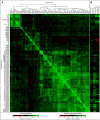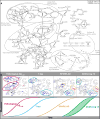Metabolic network failures in Alzheimer's disease: A biochemical road map
- PMID: 28341160
- PMCID: PMC5866045
- DOI: 10.1016/j.jalz.2017.01.020
Metabolic network failures in Alzheimer's disease: A biochemical road map
Abstract
Introduction: The Alzheimer's Disease Research Summits of 2012 and 2015 incorporated experts from academia, industry, and nonprofit organizations to develop new research directions to transform our understanding of Alzheimer's disease (AD) and propel the development of critically needed therapies. In response to their recommendations, big data at multiple levels are being generated and integrated to study network failures in disease. We used metabolomics as a global biochemical approach to identify peripheral metabolic changes in AD patients and correlate them to cerebrospinal fluid pathology markers, imaging features, and cognitive performance.
Methods: Fasting serum samples from the Alzheimer's Disease Neuroimaging Initiative (199 control, 356 mild cognitive impairment, and 175 AD participants) were analyzed using the AbsoluteIDQ-p180 kit. Performance was validated in blinded replicates, and values were medication adjusted.
Results: Multivariable-adjusted analyses showed that sphingomyelins and ether-containing phosphatidylcholines were altered in preclinical biomarker-defined AD stages, whereas acylcarnitines and several amines, including the branched-chain amino acid valine and α-aminoadipic acid, changed in symptomatic stages. Several of the analytes showed consistent associations in the Rotterdam, Erasmus Rucphen Family, and Indiana Memory and Aging Studies. Partial correlation networks constructed for Aβ1-42, tau, imaging, and cognitive changes provided initial biochemical insights for disease-related processes. Coexpression networks interconnected key metabolic effectors of disease.
Discussion: Metabolomics identified key disease-related metabolic changes and disease-progression-related changes. Defining metabolic changes during AD disease trajectory and its relationship to clinical phenotypes provides a powerful roadmap for drug and biomarker discovery.
Keywords: Acylcarnitines; Alzheimer's disease; Biochemical networks; Biomarkers; Branched-chain amino acids; Dementia; Metabolism; Metabolomics; Metabonomics; Pharmacometabolomics; Pharmacometabonomics; Phospholipids; Precision medicine; Serum; Sphingomyelins; Systems biology.
Copyright © 2017 the Alzheimer's Association. Published by Elsevier Inc. All rights reserved.
Figures





References
-
- Citron M. Alzheimer’s disease: strategies for disease modification. Nat Rev Drug Discov. 2010;9:387–98. - PubMed
-
- Procaccini C, Santopaolo M, Faicchia D, Colamatteo A, Formisano L, de Candia P, et al. Role of metabolism in neurodegenerative disorders. Metabolism. 2016;65:1376–90. - PubMed
-
- Chen Z, Zhong C. Decoding Alzheimer’s disease from perturbed cerebral glucose metabolism: implications for diagnostic and therapeutic strategies. Prog Neurobiol. 2013;108:21–43. - PubMed
MeSH terms
Substances
Grants and funding
- R01 AG019771/AG/NIA NIH HHS/United States
- R00 LM011384/LM/NLM NIH HHS/United States
- U01 AG024904/AG/NIA NIH HHS/United States
- R01 MH098260/MH/NIMH NIH HHS/United States
- P50 NS053488/NS/NINDS NIH HHS/United States
- R01 LM011360/LM/NLM NIH HHS/United States
- RF1 AG057457/AG/NIA NIH HHS/United States
- RF1 AG051550/AG/NIA NIH HHS/United States
- R01 AG046171/AG/NIA NIH HHS/United States
- P30 AG010124/AG/NIA NIH HHS/United States
- P30 AG010133/AG/NIA NIH HHS/United States
- Z99 AG999999/ImNIH/Intramural NIH HHS/United States
- R01 EB022574/EB/NIBIB NIH HHS/United States
- U19 AG024904/AG/NIA NIH HHS/United States
- K01 AG049050/AG/NIA NIH HHS/United States
- R01 LM012535/LM/NLM NIH HHS/United States
- U01 AG061359/AG/NIA NIH HHS/United States
LinkOut - more resources
Full Text Sources
Other Literature Sources
Medical

